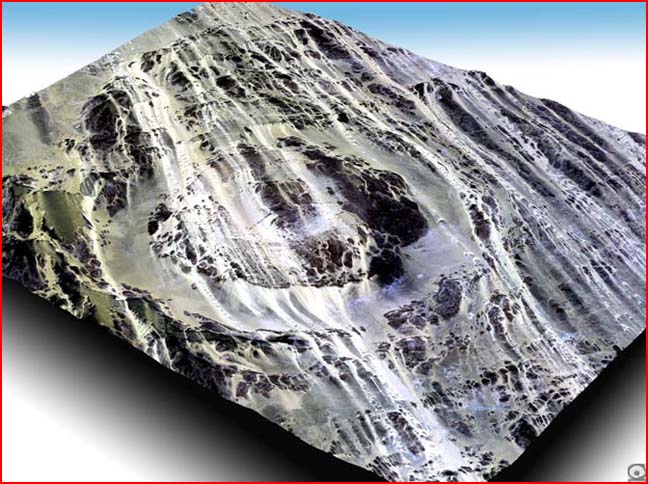
home •
about •
essential guide •
picture of the day •
thunderblogs •
news •
multimedia •
predictions •
products •
get involved •
contact
picture of the day archive subject index
Aorounga Crater 3DPlanetary and Space Science Centre (PASSC) University of New Brunswick, Canada
Image by: Dr. Carlos Roberto de Souza Filho
May 03, 2006
Aorounga CraterSatellite radar images of the Sahara desert north of Chad have revealed the presence of craters not easily noticed in normal aerial photographs. But the cause of these formations may lie outside the lexicon of standard geology today.
The Aorounga crater in the three-dimensional image above is almost 19 miles (31 kilometers) in diameter. And it does not stand alone in the Saharan desert. Its coordinates are, N 19° 6' E 19° 15', while the Kebira structure we discussed earlier can be found at N 24° 30' E 25° 0'. Both craters lie within an area of chaotic terrain that closely resembles the surface of Mars. (See Google Map) Another formation, the Oasis crater, can be seen slightly west of Kebira in the satellite image.
Some of the more interesting aspects of Aorounga are the "implausible" parallel grooves and ridges that run through the surrounding landscape, as well as through the crater itself. Wallace Thornhill and other advocates of the "Electric Universe" see these as one of the more common signatures of electrical arcing on rocky bodies in the solar system. The deep gouges and scalloped cliffs are reminiscent of Martian features that electrical theorists identify as scars left by electric arcs. The crater pattern is also eerily similar to the unexplained “pedestal craters” on Mars imaged by NASA orbiters—even the floors of many such craters stand higher the surrounding terrain. (Example from the Mars Global Surveyor seen here.)The press release from Boston University listed the Kebira formation as “millions of years old”, corresponding to the dates fixed for other areas of the Gilf Kebir Plateau. But, is that the case? Could intense electromagnetic bombardment influence the apparent age accepted by the scientific community?
The most common dating method is by measuring the isotopic ratios of particular elements. For example, uranium 235 decays into lead 207 with a half-life of 700 million years. That means, when the rock was first formed, it contained a fixed quantity of uranium 235 and every 700 million years thereafter it will exhibit half the amount of uranium 235 and an increasing amount of lead 207.
Because a mineral sample’s age depends on that sample existing today exactly as when it was initially formed, if it has been affected by radioactivity, or heat, or a blast or electricity, any measurement of its age will be inaccurate. Therefore, if a multi-billion joule electric discharge, sufficient to excavate a crater 19 miles in diameter were to strike the earth, the gamma and x-ray pulses would drastically alter the decay rate, the isotopic ratios and, perhaps, form new elements within the rocks.
For these and other reasons presented in these Pictures of the Day, it is not unreasonable to ask if Kebira and its surrounding craters may be the remains of electrical events, perhaps occurring in a more recent past than geologists have previously imagined.
Contributed by Stephen Smith
__________________________________________________________________________
Please visit our new "Thunderblog" page
Through the initiative of managing editor Dave Smith, we’ve begun the launch of a new
page called Thunderblog. Timely presentations of fact and opinion, with emphasis on
new discoveries and the explanatory power of the Electric Universe."The Electric Sky and The Electric Universe available now!

|
|

|
EXECUTIVE EDITORS:
David Talbott, Wallace Thornhill
MANAGING EDITOR:
Michael Armstrong
CONTRIBUTING EDITORS: Dwardu Cardona, Ev Cochrane,
C.J. Ransom, Don Scott, Rens van der Sluijs, Ian Tresman
WEBMASTER: Michael Armstrong
Copyright 2006: thunderbolts.info
![]()
home •
thunderblogs •
forum •
picture of the day •
resources •
team •
updates •
contact us

